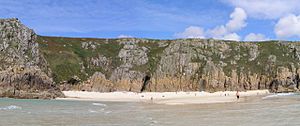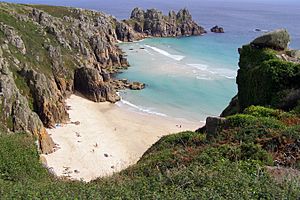Treen Cliff facts for kids
| Site of Special Scientific Interest | |
 |
|
| Area of Search | Cornwall |
|---|---|
| Coordinates | 50°02′42″N 5°38′21″W / 50.0451°N 5.6392°W |
| Interest | Biological |
| Area | 49.3 hectares (0.493 km2; 0.190 sq mi) |
| Notification | 1951 |
Treen Cliff is a special place in Cornwall, England. It's called a Site of Special Scientific Interest (SSSI). This means it's protected because of its amazing nature. You can find it on the Penwith Peninsula, about 6 miles (10 km) southwest of Penzance.
Treen Cliff was first recognized as important in 1951. It covers a large area of about 49.3 hectares (122 acres). This site is special for both its plants and animals, and its interesting rocks. Part of Treen Cliff, called Treryn Dinas, is a very old "cliff castle." It has old walls and ditches. You can also find the famous Logan Rock here.
The area is part of the Cornwall Area of Outstanding Natural Beauty (AONB). It's also part of the Penwith Heritage coast. The National Trust helps to look after some of this beautiful land.
What Makes Treen Cliff Special?
This SSSI stretches from Porthcurno beach in the west. It goes all the way to Penberth Cove in the east. Many rare plants grow here. The area is especially important for its "maritime heath." This is a type of open land found near the sea.
In 2010, experts checked the SSSI. They said it was "Unfavourable recovering." This means it's getting better, but still needs help. Some areas have too much scrub and bracken (a type of fern). These plants can take over and harm other important species. To help, the land needs to be grazed by animals. Also, trees like sycamore should be removed. This helps control other plants that don't belong here.
Amazing Plants and Animals
Plant Communities
Treen Cliff has several types of plant areas. These include maritime heath, maritime grassland, and small areas of woodland.
The maritime heath is full of plants like heather (Calluna vulgaris). You'll also see bell heather (Erica cinerea) and western gorse (Ulex gallii).
On the steep cliff slopes, you'll find maritime grassland. Red fescue (Festuca rubra) is common here. Other plants include spring squill (Scilla verna) and wild carrot (Daucus carota). You might also spot kidney vetch (Anthyllis vulneraria) and sea plantain (Plantago maritima).
Some very rare plants grow here too. The western clover (Trifolium occidentale) is on the IUCN Red List. This list shows plants that are at risk. The nationally rare hare's foot clover (Trifolium arvense) also lives here. Other special plants are hairy bird's-foot trefoil (Lotus subbiflorus) and bird's-foot fenugreek (Trifolium ornithopodioides).
Large parts of the cliff are covered in scrub. This is mostly gorse (Ulex europaeus) and blackthorn (Prunus spinosa). This scrub provides homes for insects and birds. Common dodder (Cuscuta epithymum) is a plant that grows on the gorse.
There are also wet areas called flushes along the coast. These are dominated by common reed (Phragmites australis). A small woodland area has grown on old garden plots. It has elm (Ulmus glabra) and sycamore trees.
Jean Lawman, a writer, described the area beautifully:
Also in June, many of the cliffs are bright with Oxeye Daisies Leucanthemum vulgare and they are particularly abundant around Logan Rock and Porth Curnow area where they mix with foxgloves and button like, mauve Sheepsbit Jasione montana. The spectacle of all these flowers strewn along the cliff edge, with the classically beautiful Pednevounder beach below and the rugged headland of Treryn Dinas in the distance, must be one of the loveliest in Cornwall.
Rock sea lavender (Limonium loganicum) is a very special plant. It is endemic, meaning it's found only here. You can only see it along this part of the coast. It grows from Carn Les Boel to the Logan Rock. All these plants are within the SSSI. But they can be at risk from climbers or walkers on the lower slopes.
Invertebrates
Treen Cliff is home to many interesting invertebrates. Invertebrates are animals without backbones, like insects.
A nationally rare weevil called Anthonomus rufus lives on the cliffs. It is often found near blackthorn plants. Its young (larvae) likely grow inside the blackthorn flower buds. This weevil used to be common in coastal Britain, but now it's only found in a few places.
You can also find different types of butterflies here. There are colonies of the silver-studded blue (Plebejus argus). The small pearl-bordered fritillary (Boloria selene) lives on Cribba Head. This is in the eastern part of the site. The thrift clearwing (Synansphecia muscaeformis) is a type of moth that flies during the day.


